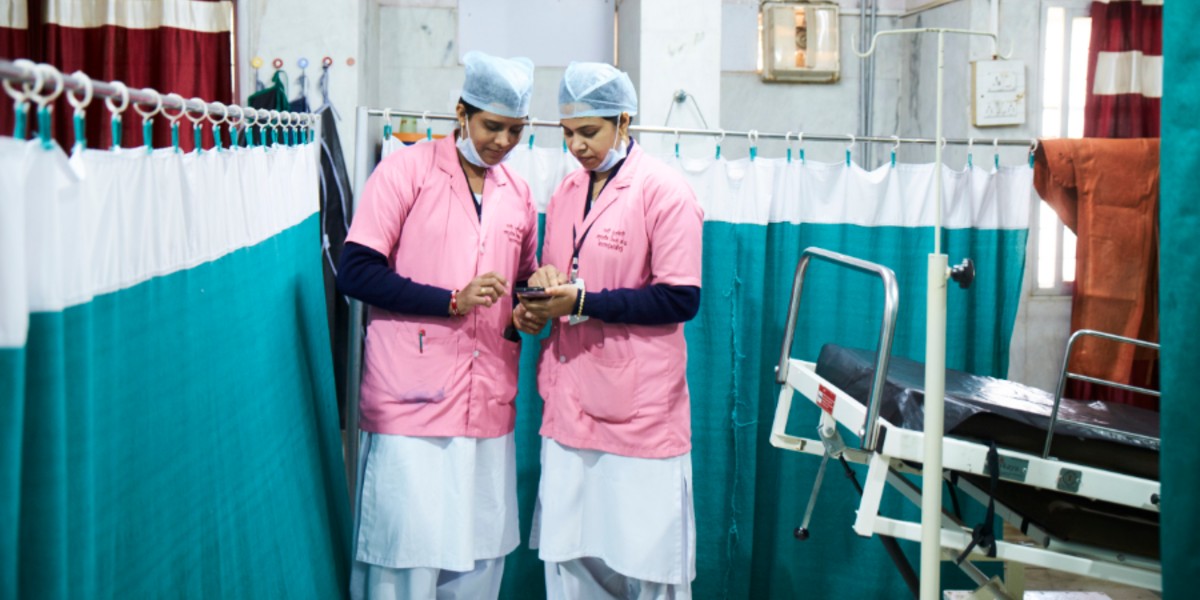Skilled birth attendants in India use the Safe Delivery App to stay updated during Corona
In India, skilled birth attendants are using the Safe Delivery App to prepare themselves and their labour wards to provide safer births for mothers and their newborns during the covid-19 pandemic.
Even prior to the covid-19 pandemic health care workers in India, as in many settings, struggled to access the latest evidence-based medical guidelines. When our team at Maternity Foundation traveled across the country earlier this year, we heard this time and time again from staff nurses, doctors, and hospital administrators – for instance from staff nurse Barti Sinha at Chrama Community Health Center in Chhattisgarh state:
“Before the Safe Delivery App, we used to all have different practices; we had studied different places and learned in different ways.”
Since the Government of India in partnership with Maternity Foundation introduced the Safe Delivery App as a training and job aid to skilled birth attendants in India, Almost 90,000 health workers have downloaded the App, meaning they now have access to updated national guidelines to support them in their work – no matter where or when they went to school:
“All the young nurses who come here know the latest procedures and guidelines, and I used to struggle to keep up. But now I know too. I’m updated about all the latest knowledge through the Safe Delivery App, and now I’m on the same level as them. You’re never too old to learn,” Rajinder Kaur, nursing sister at Mata Kaushalya Government Hospital in Patiyala, Punjab says.
Covid-19 support straight from the pocket
The Covid-19 pandemic has intensified the need for access to the latest guidelines in real time, as new evidence emerges rapidly, protocols change day to day and myths – often fueled by fear or miscommunication – are ramped. Anita Sharma, a nursing officer based at the Mohali District Hospital in the state of Punjab, describes how vital it was for her and her team to have tools to guide them in how to handle their first covid-19 case.
“When the first case of Covid-19 was documented in the district of Mohali back in March, there was just one private hospital taking covid-19 patients. That changed in July, when we were presented with a number of labouring mothers who were Covid-19 positive. Rather than turn them away, we used the Safe Delivery App, which we already had on our phone, and our knowledge from the government’s training program program, to guide us through what to do,” says Anita Sharma.
The team at Mohali District Hospital quickly created a separate labor ward specifically for mothers with covid-19, and carefully followed infection prevention protocols. This was an achievement for all the staff, but it was also a wake-up call that they needed to be more prepared for future cases that would inevitably come. Since then, they created a separate labour ward and nursing room for women that have covid-19, a separate room for attendants, and are planning to create a NICU for babies born with covid-19.
Anita Sharma says she and her colleagues continue to use the Safe Delivery App to manage complications during pregnancy and handle infection prevention. All staff nurses in the hospital are Safe Delivery Champions –meaning that they passed a rigorous series of exams on e-learning platform, MyLearning, on the App.
MyLearning on the rise
With more than half of the global number of users on MyLearning being from India, the individualized e-learning platform has become an essential learning tool for skilled birth attendants across India – not least with the new covid-19 addition.
Maternity Foundation can see from app usage analytics that users are progressing much faster through knowledge levels on MyLearning on covid-19 compared with the rest of the content on the App. This suggests that skilled birth attendants, just like Anita, are hungry for information and eager to improve their knowledge on how to provide quality maternal care during the corona pandemic – and that the Safe Delivery App is an effective and user-friendly way to get it.





